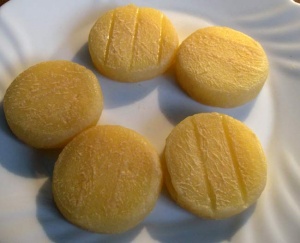A large listeriosis outbreak occurred in Austria, Germany and the Czech Republic in 2009 and 2010. The outbreak was traced back to a traditional Austrian curd cheese called Quargel which was contaminated with two distinct serovar 1/2a Listeria monocytogenes strains (QOC1 and QOC2).
 Quargel is an acid curd cheese with a red smear made from skimmed pasteurized milk. Some recalled Quargel lots were highly contaminated with up to 106–108 colony forming units (CFU) of L. monocytogenes per gram of cheese.
Quargel is an acid curd cheese with a red smear made from skimmed pasteurized milk. Some recalled Quargel lots were highly contaminated with up to 106–108 colony forming units (CFU) of L. monocytogenes per gram of cheese.
From June 2009 to January 2010 Quargel outbreak clone 1 (hereafter: QOC1) was the cause of 14 cases, including 5 with a fatal outcome, while between December 2009 and February 2010, clone 2 (hereafter: QOC2) accounted for 20 cases, which resulted in 3 fatalities. No maternal or neonatal case had been reported. The median age of the cases was 72 years (range 57 to 89) and 76% of the patients were male. Of the 34 patients, 25 were Austrian, 8 were German and one was from the Czech Republic.
Rychli et al. report we sequenced and analysed the genomes of both outbreak strains in order to investigate the extent of genetic diversity between the two strains belonging to MLST sequence types 398 (QOC2) and 403 (QOC1). Both genomes are highly similar, but also display distinct properties: The QOC1 genome is approximately 74 kbp larger than the QOC2 genome. In addition, the strains harbour 93 (QOC1) and 45 (QOC2) genes encoding strain-specific proteins. A 21 kbp region showing highest similarity to plasmid pLMIV encoding three putative internalins is integrated in the QOC1 genome. In contrast to QOC1, strain QOC2 harbours a vip homologue, which encodes a LPXTG surface protein involved in cell invasion. In accordance, in vitro virulence assays revealed distinct differences in invasion efficiency and intracellular proliferation within different cell types. The higher virulence potential of QOC1 in non-phagocytic cells may be explained by the presence of additional internalins in the pLMIV-like region, whereas the higher invasion capability of QOC2 into phagocytic cells may be due to the presence of a vip homologue. In addition, both strains show differences in stress-related gene content. Strain QOC1 encodes a so-called stress survival islet 1, whereas strain QOC2 harbours a homologue of the uncharacterized LMOf2365_0481 gene. Consistently, QOC1 shows higher resistance to acidic, alkaline and gastric stress. In conclusion, our results show that strain QOC1 and QOC2 are distinct and did not recently evolve from a common ancestor.
